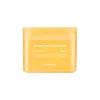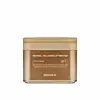What's inside
What's inside
 Key Ingredients
Key Ingredients

 Benefits
Benefits

 Concerns
Concerns

 Ingredients Side-by-side
Ingredients Side-by-side

Water
Skin ConditioningDipropylene Glycol
HumectantNiacinamide
SmoothingGlycereth-26
Humectant1,2-Hexanediol
Skin ConditioningHippophae Rhamnoides Water
MaskingHydroxyacetophenone
AntioxidantBetaine
HumectantOctyldodeceth-16
EmulsifyingHydroxyethyl Urea
HumectantAllantoin
Skin ConditioningDipotassium Glycyrrhizate
HumectantTrehalose
HumectantXanthan Gum
EmulsifyingHydroxyethylcellulose
Emulsion StabilisingPolyglyceryl-10 Laurate
Skin ConditioningDisodium EDTA
Olea Europaea Fruit Oil
MaskingHydrogenated Lecithin
EmulsifyingPelargonium Graveolens Flower Oil
MaskingLavandula Angustifolia Oil
MaskingAnthemis Nobilis Flower Oil
MaskingCitrus Aurantium Dulcis Peel Oil
MaskingJuniperus Mexicana Oil
MaskingRiboflavin
Cosmetic ColorantSodium Ascorbyl Phosphate
AntioxidantPyridoxine Hcl
Skin ConditioningRetinol
Skin ConditioningTocopheryl Acetate
AntioxidantMenadione
MaskingThiamine Hcl
MaskingCitronellol
PerfumingLinalool
PerfumingGeraniol
PerfumingLimonene
PerfumingWater, Dipropylene Glycol, Niacinamide, Glycereth-26, 1,2-Hexanediol, Hippophae Rhamnoides Water, Hydroxyacetophenone, Betaine, Octyldodeceth-16, Hydroxyethyl Urea, Allantoin, Dipotassium Glycyrrhizate, Trehalose, Xanthan Gum, Hydroxyethylcellulose, Polyglyceryl-10 Laurate, Disodium EDTA, Olea Europaea Fruit Oil, Hydrogenated Lecithin, Pelargonium Graveolens Flower Oil, Lavandula Angustifolia Oil, Anthemis Nobilis Flower Oil, Citrus Aurantium Dulcis Peel Oil, Juniperus Mexicana Oil, Riboflavin, Sodium Ascorbyl Phosphate, Pyridoxine Hcl, Retinol, Tocopheryl Acetate, Menadione, Thiamine Hcl, Citronellol, Linalool, Geraniol, Limonene
Water
Skin ConditioningDipropylene Glycol
HumectantGlycereth-26
HumectantBetaine
Humectant1,2-Hexanediol
Skin ConditioningGlycerin
HumectantDiphenyl Dimethicone
EmollientHydroxyacetophenone
AntioxidantTriethylhexanoin
MaskingHydrogenated Lecithin
EmulsifyingAllantoin
Skin ConditioningOctyldodeceth-16
EmulsifyingPolyglyceryl-10 Oleate
Skin ConditioningSphingomonas Ferment Extract
Skin ConditioningAdenosine
Skin ConditioningDisodium EDTA
Sodium Polyacrylate
AbsorbentHydrolyzed Collagen
EmollientLavandula Angustifolia Oil
MaskingPhytosterols
Skin ConditioningAnthemis Nobilis Flower Oil
MaskingRetinol
Skin ConditioningBeta-Glucan
Skin ConditioningCeramide NP
Skin ConditioningWater, Dipropylene Glycol, Glycereth-26, Betaine, 1,2-Hexanediol, Glycerin, Diphenyl Dimethicone, Hydroxyacetophenone, Triethylhexanoin, Hydrogenated Lecithin, Allantoin, Octyldodeceth-16, Polyglyceryl-10 Oleate, Sphingomonas Ferment Extract, Adenosine, Disodium EDTA, Sodium Polyacrylate, Hydrolyzed Collagen, Lavandula Angustifolia Oil, Phytosterols, Anthemis Nobilis Flower Oil, Retinol, Beta-Glucan, Ceramide NP
 Reviews
Reviews

Ingredients Explained
These ingredients are found in both products.
Ingredients higher up in an ingredient list are typically present in a larger amount.
1,2-Hexanediol is a synthetic liquid and another multi-functional powerhouse.
It is a:
- Humectant, drawing moisture into the skin
- Emollient, helping to soften skin
- Solvent, dispersing and stabilizing formulas
- Preservative booster, enhancing the antimicrobial activity of other preservatives
Allantoin is a soothing ingredient known for its protective and moisturizingg properties. Because of this, it is often added to products with strong active ingredients.
Studies show higher concentrations of this ingredient can promote wound healing.
Though it can be derived from the comfrey plant, allantoin is produced synthetically for cosmetic products to ensure purity.
Learn more about AllantoinThis oil is created by distilling the dried flower heads of the Roman Chamomile flower.
Chamomile is rich in antioxidants and has anti-inflammatory properties. Several compounds found in chamomile help with soothing, such as bisbolol.
Betaine is a common humectant (a substance that promotes retention of moisture). It's known to be gentle on the skin and can help balance hydration.
This ingredient is best for improving hydration and soothing irritated skin. Studies also show it helps even out skin tone.
Fun fact: Betaine is naturally created in the skin and body. The kind found within cosmetic products can be either plant-derived or synthetic.
Another name for betaine is trimethylglycine.
Learn more about BetaineDipropylene Glycol is a synthetically created humectant, stabilizer, and solvent.
This ingredient helps:
Dipropylene glycol is technically an alcohol, but it belongs to the glycol family (often considered part of the ‘good’ alcohols). This means it is hydrating and gentle on skin unlike drying solvent alcohols like denatured alcohol.
As a masking agent, Dipropylene Glycol can be used to cover the smell of other ingredients. However, it does not have a scent.
Studies show Dipropylene Glycol is considered safe to use in skincare.
Learn more about Dipropylene GlycolDisodium EDTA plays a role in making products more stable by aiding other preservatives.
It is a chelating agent, meaning it neutralizes metal ions that may be found in a product.
Disodium EDTA is a salt of edetic acid and is found to be safe in cosmetic ingredients.
Learn more about Disodium EDTAGlycereth-26 is a synthetic ingredient and polyethylene glycol ether of Glycerin. Glycerin is already naturally found in your skin and helps keep your skin moisturized.
It is a humectant and helps add texture to products. It can make your product thicker.
As a humectant, it helps draw moisture from the air to your skin. This helps your skin stay hydrated.
Learn more about Glycereth-26Hydrogenated Lecithin is created from the hydrogenation of lecithin (a group of phospholipids). Hydrogenation is a chemical reaction between hydrogen and another element.
This ingredient is an emollient and emulsifier. As an emollient, it helps soften skin by trapping moisture within. As an emulsifier, it prevents oil and water ingredients from separating.
Hydroxyacetophenone is antioxidant with skin conditioning and soothing properties. It also boosts the efficiency of preservatives.
This ingredient is not irritating or sensitizing.
Lavandula Angustifolia Oil is more commonly known as lavender essential oil. It is considered a fragrancing ingredient.
Lavender imparts a famous scent. While the smell is lovely, this ingredient and may sensitize skin in topical products. This is because about 85% of the oil is made up of linalool and linalyl acetate.
When exposed to air, these two compounds become strong allergens. This ingredient exhibits cytotoxicity at low concentrations; amounts of 0.25% have been shown to damage skin cells.
A study from Japan found this ingredient caused lavender sensitivity after widespread exposure.
Lavender essential oil has some antimicrobial, antibacterial, and anti-inflammatory properties. However, the cons of this ingredient may outweight the pros.
More research is needed to confirm lavender essential oil's effects when used in aromatherapy.
Lavandula Angustifolia is known as the English Lavender and famous for creating purple fields in Provence, France.
Learn more about Lavandula Angustifolia OilOctyldodeceth-16 comes from the fatty-alcohol Octyldodecanol.
Emulsifers keep oils and water ingredients together to create a more even consistency.
Retinol is a gold-standard ingredient for anti-aging. It is a form of Vitamin A and belongs to the class of retinoids that also includes tretinoin.
Why is retinol famous?
It has the most scientific studies backing up its skin benefits out of all the non-prescription ingredients.
Retinol is proven to:
This is why retinol is effective at removing wrinkles, fading dark spots, treating acne, and reducing the appearance of pores.
Studies show retinol is less effective when exposed to UV. Be sure to look for appropriate packaging to keep your retinol potent (similar to Vitamin C).
Using retinol or any retinoids will increase sun-sensitivity in the first few months. Though studies show retinoids increase your skin's natural SPF with continuous use, it is best to always wear sunscreen and sun-protection.
We recommend speaking with a medical professional about using this ingredient during pregnancy.
Retinol may cause irritation in some people, so be sure to patch test. Experts recommend 'ramping up' retinol use: start using this ingredient once a week and work up to using it daily.
Read about Tretinoin
Learn more about RetinolWater. It's the most common cosmetic ingredient of all. You'll usually see it at the top of ingredient lists, meaning that it makes up the largest part of the product.
So why is it so popular? Water most often acts as a solvent - this means that it helps dissolve other ingredients into the formulation.
You'll also recognize water as that liquid we all need to stay alive. If you see this, drink a glass of water. Stay hydrated!
Learn more about Water